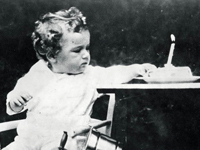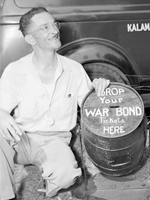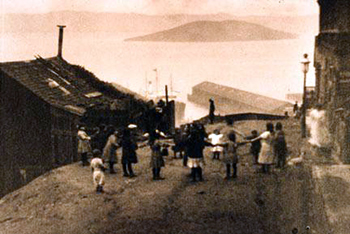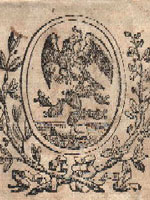1. It was after dark when we came in sight of the camp and a dismal looking it is the tents are all huddled in together and the wagons are interspersed some are singing and laughing some are praying children crying &c. every sound may be heard from one tent to another . . .
This entry comes from a diary recording one woman's experience on:
c. The Mormon Trail
 In her diary, 18-year-old Emmeline B. Wells describes her experiences on the trail from Nauvoo, IL, to Garden Grove, IA. In 1846, Mormons, followers of the Church of Latter-day Saints, began to migrate west from their settlement in Nauvoo due to persecution, following a trail that, for much of its length, closely followed the Oregon Trail. Wells's diary describes the first half of this journey; as 1846 ended, the Mormons would winter in Iowa and then continue on to the territory that would become Utah. Wells relates experiences both general to all trailgoers and specific to women—the diary ends with her husband unexpectedly abandoning her, and her grief at the event.
In her diary, 18-year-old Emmeline B. Wells describes her experiences on the trail from Nauvoo, IL, to Garden Grove, IA. In 1846, Mormons, followers of the Church of Latter-day Saints, began to migrate west from their settlement in Nauvoo due to persecution, following a trail that, for much of its length, closely followed the Oregon Trail. Wells's diary describes the first half of this journey; as 1846 ended, the Mormons would winter in Iowa and then continue on to the territory that would become Utah. Wells relates experiences both general to all trailgoers and specific to women—the diary ends with her husband unexpectedly abandoning her, and her grief at the event.
2. There were no battlefields, but over every mile of the long trail stalked the shadow of death. And what was waiting to greet us in [. . .]? A wilderness marked by faint trails of wild Indian feet (wilder than wild animals that would tear with bloody claws) and slow, agonizing death caused by the poison fangs of rattlesnakes who were in countless numbers.
This paragraph from a memoir by a female pioneer describes which state?
b. California
 Lee Summers Whipple-Haslam, near the end of her life, wrote a memoir of her experiences as a child traveling to and living in California during the Gold Rush. Whipple-Haslam's parents brought her to California in 1850, where her mother ran a boarding house and her father prospected. Critics accused the memoir, published in 1925, of being more nostalgic fantasy than precise memory, but it still provides one woman's latter-life interpretation of the Gold Rush and California settlement.
Lee Summers Whipple-Haslam, near the end of her life, wrote a memoir of her experiences as a child traveling to and living in California during the Gold Rush. Whipple-Haslam's parents brought her to California in 1850, where her mother ran a boarding house and her father prospected. Critics accused the memoir, published in 1925, of being more nostalgic fantasy than precise memory, but it still provides one woman's latter-life interpretation of the Gold Rush and California settlement.
3. We all take names - Wajapa names me, Ma-she-ha-the. It means, The motion of eagle as he sweeps high in the air. He gives me the name of his family and band. He belongs to the eagle family. Ma-she means high, ha-the means eagle.
In this diary extract, a woman is describing an encounter with which Native American group?
a. The Dakota Sioux
 In this excerpt from her September 23, 1881 diary entry, ethnologist Alice Fletcher describes her assumption of a Sioux Dakota name before spending a month and a half studying the lives of Native Americans in the Dakota Territory. Fletcher, a woman from a well-off family, had developed a vocational interest in ethnology that led her to undertake this study. Like many other male and female reformers of the day, she would go on to attempt to "civilize" Native American culture through education and political action.
In this excerpt from her September 23, 1881 diary entry, ethnologist Alice Fletcher describes her assumption of a Sioux Dakota name before spending a month and a half studying the lives of Native Americans in the Dakota Territory. Fletcher, a woman from a well-off family, had developed a vocational interest in ethnology that led her to undertake this study. Like many other male and female reformers of the day, she would go on to attempt to "civilize" Native American culture through education and political action.
4.

In this image, a female photographer captures a scene in what city?
b. San Francisco
Words aren't the only medium in which women could capture their life experiences in the West. Here, photographer Laura Adams Armer records a street scene from San Francisco, c. 1910. Armer worked as a portrait photographer in San Francisco in the early 1900s, taking time to preserve not only portraits of native San Franciscans but also photographs of the life of the city—and, later in her career, of the lives of southwestern Native Americans, particularly Navajo communities.


 John Adams, from Abigail Adams (pictured). Abigail Adams wrote this to her husband in a December 23, 1782 letter. The original letter can be read
John Adams, from Abigail Adams (pictured). Abigail Adams wrote this to her husband in a December 23, 1782 letter. The original letter can be read  Woodrow Wilson, to Edith Bolling Galt (pictured). This is from a letter that widower President Wilson wrote from the White House on September 19, 1915, to Edith Bolling Galt, whom he would marry. The full text of the letter is in volume 34 of The Papers of Woodrow Wilson, ed. Arthur Stanley Link (Princeton, NJ: Princeton University Press, 1994), page 491.
Woodrow Wilson, to Edith Bolling Galt (pictured). This is from a letter that widower President Wilson wrote from the White House on September 19, 1915, to Edith Bolling Galt, whom he would marry. The full text of the letter is in volume 34 of The Papers of Woodrow Wilson, ed. Arthur Stanley Link (Princeton, NJ: Princeton University Press, 1994), page 491. Ronald Reagan, to Nancy Reagan (pictured). This is from a letter written on White House stationery by Ronald Reagan, to his wife Nancy on March 4, 1981. From Nancy Reagan, I Love You, Ronnie: The Letters of Ronald Reagan to Nancy Reagan (New York: Random House, 2002).
Ronald Reagan, to Nancy Reagan (pictured). This is from a letter written on White House stationery by Ronald Reagan, to his wife Nancy on March 4, 1981. From Nancy Reagan, I Love You, Ronnie: The Letters of Ronald Reagan to Nancy Reagan (New York: Random House, 2002). Theodore Roosevelt, about Alice Lee (pictured). This is from Roosevelt's diary entry of February 13, 1880. On that evening, he became engaged to Alice Lee, whom he married. On Valentine's Day, 1884, she died while giving birth to their daughter Alice. Roosevelt's mother died the same day. His diary entry for that day is simply a large black X with the words, "The light has gone out of my life." The Library of Congress has made scans of the original diary pages, available online
Theodore Roosevelt, about Alice Lee (pictured). This is from Roosevelt's diary entry of February 13, 1880. On that evening, he became engaged to Alice Lee, whom he married. On Valentine's Day, 1884, she died while giving birth to their daughter Alice. Roosevelt's mother died the same day. His diary entry for that day is simply a large black X with the words, "The light has gone out of my life." The Library of Congress has made scans of the original diary pages, available online 


 In her diary, 18-year-old Emmeline B. Wells describes her experiences on the trail from Nauvoo, IL, to Garden Grove, IA. In 1846, Mormons, followers of the Church of Latter-day Saints, began to migrate west from their settlement in Nauvoo due to persecution, following a trail that, for much of its length, closely followed the Oregon Trail. Wells's diary describes the first half of this journey; as 1846 ended, the Mormons would winter in Iowa and then continue on to the territory that would become Utah. Wells relates experiences both general to all trailgoers and specific to women—the diary ends with her husband unexpectedly abandoning her, and her grief at the event.
In her diary, 18-year-old Emmeline B. Wells describes her experiences on the trail from Nauvoo, IL, to Garden Grove, IA. In 1846, Mormons, followers of the Church of Latter-day Saints, began to migrate west from their settlement in Nauvoo due to persecution, following a trail that, for much of its length, closely followed the Oregon Trail. Wells's diary describes the first half of this journey; as 1846 ended, the Mormons would winter in Iowa and then continue on to the territory that would become Utah. Wells relates experiences both general to all trailgoers and specific to women—the diary ends with her husband unexpectedly abandoning her, and her grief at the event. Lee Summers Whipple-Haslam, near the end of her life, wrote a memoir of her experiences as a child traveling to and living in California during the Gold Rush. Whipple-Haslam's parents brought her to California in 1850, where her mother ran a boarding house and her father prospected. Critics accused the memoir, published in 1925, of being more nostalgic fantasy than precise memory, but it still provides one woman's latter-life interpretation of the Gold Rush and California settlement.
Lee Summers Whipple-Haslam, near the end of her life, wrote a memoir of her experiences as a child traveling to and living in California during the Gold Rush. Whipple-Haslam's parents brought her to California in 1850, where her mother ran a boarding house and her father prospected. Critics accused the memoir, published in 1925, of being more nostalgic fantasy than precise memory, but it still provides one woman's latter-life interpretation of the Gold Rush and California settlement.  In this excerpt from her September 23, 1881 diary entry, ethnologist Alice Fletcher describes her assumption of a Sioux Dakota name before spending a month and a half studying the lives of Native Americans in the Dakota Territory. Fletcher, a woman from a well-off family, had developed a vocational interest in ethnology that led her to undertake this study. Like many other male and female reformers of the day, she would go on to attempt to "civilize" Native American culture through education and political action.
In this excerpt from her September 23, 1881 diary entry, ethnologist Alice Fletcher describes her assumption of a Sioux Dakota name before spending a month and a half studying the lives of Native Americans in the Dakota Territory. Fletcher, a woman from a well-off family, had developed a vocational interest in ethnology that led her to undertake this study. Like many other male and female reformers of the day, she would go on to attempt to "civilize" Native American culture through education and political action.
 Read the
Read the 
